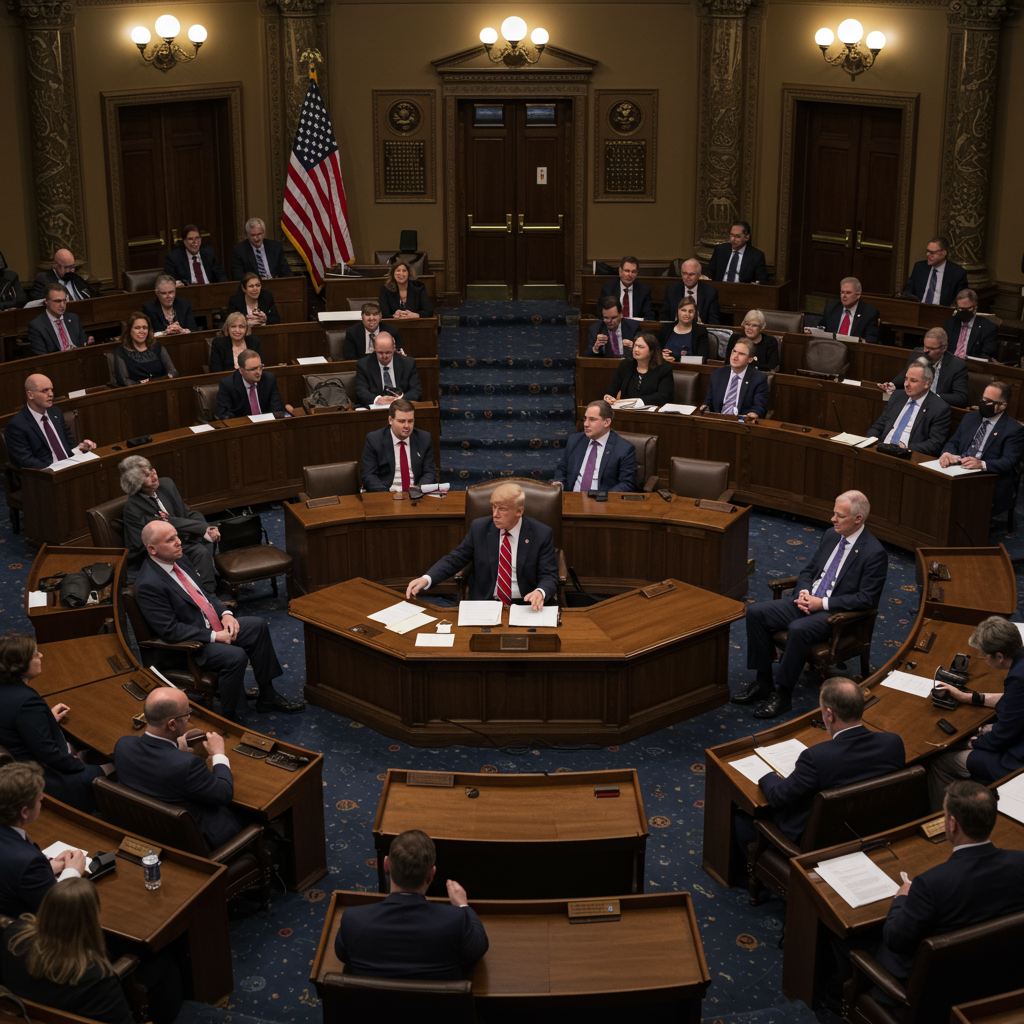The United States Senate recently saw a dramatic late-night vote. Republicans narrowly advanced a significant domestic policy package tied to President Donald Trump’s agenda. This move followed intense negotiations and procedural maneuvering. GOP leaders are racing against a self-imposed deadline: getting the massive bill passed and sent to President Trump for signing by the Fourth of July.
High-Stakes Senate Showdown
This legislative push represents a crucial moment for the Republican party. They hold slim majorities in both the House and Senate. Passing this comprehensive bill requires near-total unity among their ranks. The package, often called President Trump’s “big, beautiful bill,” combines sweeping tax cuts with significant spending reductions.
The Narrow Procedural Win
A key procedural vote, the motion to proceed to debate the bill, passed with a tight 51-49 margin. Vice President JD Vance was present, ready to break a potential tie. The vote occurred after hours of delay. GOP leaders worked frantically to secure support from wavering senators. Ultimately, two Republicans, North Carolina’s Sen. Thom Tillis and Kentucky’s Sen. Rand Paul, joined all Democrats in opposing the measure.
Sen. Ron Johnson of Wisconsin also initially opposed the motion. He later switched his vote after holdouts reportedly secured a vote on an amendment. This amendment aims to make it harder for single, childless able-bodied individuals to receive medicaid.
Decoding the Comprehensive Bill
The legislative package is extensive, reportedly spanning 940 pages. Its core purpose is making permanent the tax cuts enacted in 2017 under the Trump administration. These cuts are otherwise set to expire soon. The bill also proposes new tax breaks, including eliminating taxes on tips and overtime pay.
On the spending side, the bill includes a significant $150 billion increase in military spending for the current year. It also allocates funds for enhanced immigration enforcement and mass deportations, a key part of President Trump’s agenda.
Offsetting Costs and Controversial Cuts
To pay for the substantial tax cuts and new spending, the bill proposes cuts to various federal programs. These include reductions to Medicaid, which provides health coverage for low-income Americans, and the Supplemental Nutrition Assistance Program (SNAP), commonly known as food stamps. Funding for clean energy initiatives is also targeted for reduction. Additionally, the bill includes a provision to increase the national debt ceiling by $5 trillion ahead of an upcoming August deadline. Another long-standing conservative priority included is prohibiting Medicaid funding for entities that provide abortions, such as Planned Parenthood.
CBO Analysis Reveals Significant Impacts
The nonpartisan Congressional Budget Office (CBO) released a critical analysis of the bill. The CBO projected the bill would add $3.3 trillion to the U.S. national debt over the next decade. They estimated revenues would decrease by roughly $4.5 trillion. Proposed spending cuts amount to about $1.2 trillion compared to existing law.
The CBO analysis also highlighted the bill’s potential impact on healthcare coverage. It projected an additional 11.8 million people would become uninsured by 2034 under the Senate version. The analysis also noted the distributional effects of the bill. Top income-earners would see substantial tax reductions. Meanwhile, the poorest Americans would likely face increased costs, averaging around $1,600 under a related House version.
Internal Republican Divisions Emerge
The bill faces significant dissent even within the Republican ranks. Many senators have voiced concerns about specific provisions.
Sen. Thom Tillis strongly opposed the Medicaid cuts. He stated these cuts could result in billions in lost funding for states like North Carolina. This could force states to eliminate coverage for hundreds of thousands in the Medicaid expansion population. It might also reduce services for those already enrolled in traditional Medicaid.
Sen. Rand Paul criticized the bill for its impact on the national debt. He argued it functions more like a spending bill than a fiscal responsibility measure.
Sen. Susan Collins of Maine voted to advance the bill for debate. However, she indicated she was “leaning against” final passage. She seeks substantial revisions. She particularly favors allowing higher taxes on the wealthiest earners, a proposal expected to face stiff opposition from her GOP colleagues.
Sen. Josh Hawley of Missouri voted for the procedural motion. He cited last-minute changes beneficial to his state regarding provider taxes. Despite this, he expressed significant reservations about the Medicaid cuts. Hawley called for the GOP to avoid taking away healthcare from working people. Fiscal conservatives like Sen. Rick Scott of Florida are pushing for even deeper spending cuts. They argue for achieving “fiscal sanity.” Sen. Ron Johnson is also seeking deeper cuts. He wants spending rolled back to pre-pandemic levels and worries the bill adds to the deficit.
Negotiating Compromises Amid Dissent
GOP leaders have engaged in intense negotiations to address these internal divisions. One compromise related to the controversial Medicaid provider tax. This proposal faced parliamentary objections and opposition from senators concerned about rural hospitals. The revision included delaying the start date for cuts and establishing a $25 billion fund over five years. This fund is intended to aid rural hospitals and providers. Despite this, concerns remain about the adequacy of this funding. Sen. Collins has suggested the fund should be closer to $100 billion.
Procedural Hurdles and the SALT Debate
The legislative process is complicated by the Senate’s “Byrd Rule.” This rule limits the inclusion of non-budgetary policy matters in budget reconciliation bills. Reconciliation allows passage with a simple majority (51 votes) instead of the usual 60. However, provisions must primarily affect the budget to qualify. Initial proposals, such as shifting food stamp costs to states or altering the Consumer Financial Protection Bureau’s funding, were ruled out of compliance. Republicans quickly revised and reinstated them. Provisions from the House version deemed non-compliant, like barring nationwide judicial injunctions, have been removed.
Another unresolved issue is the deduction for state and local taxes (SALT). The current cap is $10,000. The Senate draft includes a compromise. It raises the cap to $40,000, but only for five years. This differs from the ten-year extension sought in the House version. This provision remains contentious. Some Republicans find it too generous, while House Republicans from high-tax states still view the $10,000 cap as unfair and the compromise insufficient. They have threatened to vote against the bill if the SALT break isn’t adequately addressed.
Pressure from the Top and External Reactions
President Trump is actively applying pressure to lawmakers. He is urging them to pass the bill swiftly to meet his July Fourth deadline. He has used social media and private calls to admonish holdouts and push for action. He even publicly attacked Sen. Tillis for his vote, threatening to meet with primary challengers.
The bill has also drawn sharp criticism from outside government. Billionaire Elon Musk, for instance, called the package “utterly insane and destructive.” He argued it would harm jobs and the country. Democrats are also fiercely opposed. Senate Minority Leader Chuck Schumer has criticized the late-night release of the bill text and the rushed timeline. Democrats employed a delay tactic, forcing clerks to read the entire 940-page bill aloud on the Senate floor. This process began Saturday night and was expected to continue for hours.
What Comes Next in the Legislative Battle
Despite clearing the initial procedural hurdle, the bill faces a lengthy process. Following the reading of the bill, up to 20 hours of general debate are scheduled. This will be followed by an unlimited amendment process, known as a “vote-a-rama.” This involves a marathon series of votes on various amendments.
Republican leaders are working to solidify support from senators who still seek changes. Even with the 53-47 majority, final passage is far from guaranteed. If the bill passes the Senate, it must then return to the House of Representatives. The House passed its own version in May, but differences exist. The House must agree to the Senate version before it can go to the President. The July Fourth deadline remains a significant factor driving the legislative schedule.
Frequently Asked Questions
What exactly is in the controversial Trump/GOP bill?
The extensive bill combines significant tax breaks, primarily making Trump’s 2017 tax cuts permanent and adding new breaks like eliminating taxes on tips. To offset costs, it includes substantial spending cuts to programs like Medicaid, food stamps (SNAP), and clean energy funding. It also boosts military spending and funds for immigration enforcement. The CBO projects it would increase the national debt and lead to over 11 million more uninsured people.
Which Senators are opposing the bill and why?
Several Republican senators have opposed or raised concerns. Sen. Thom Tillis opposes deep Medicaid cuts impacting healthcare access in his state. Sen. Rand Paul criticizes the bill for significantly raising the national debt. Sen. Susan Collins seeks major revisions, including allowing higher taxes on the wealthy, and views current Medicaid cuts as too severe. Other senators like Josh Hawley and Ron Johnson also have significant reservations about the spending cuts or lack of deeper reductions.
How might the bill’s cuts affect healthcare access?
The bill proposes significant cuts to Medicaid, a program covering low-income individuals, the elderly, and the disabled. The CBO projects these cuts, combined with other changes, could result in 11.8 million more Americans losing health insurance coverage over ten years. Some senators worry the cuts could force states to reduce eligibility or services and potentially lead to hospital closures, especially in rural areas that rely heavily on Medicaid funding.
This legislative battle is far from over. Republicans face a challenging path to unite their party and navigate complex procedural rules. All this must happen under intense pressure to meet President Trump’s ambitious July Fourth deadline. The outcome will have significant implications for tax policy, federal spending, healthcare access, and the national debt. The coming days in the Senate will be critical in determining the fate of this sweeping legislative package.




